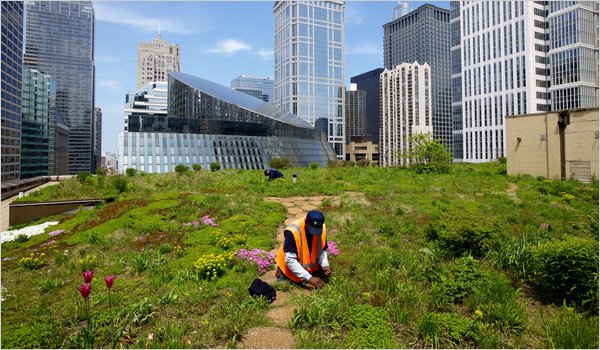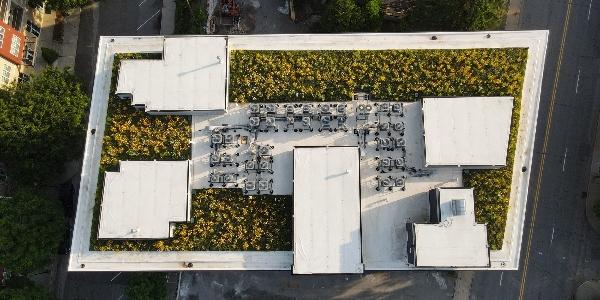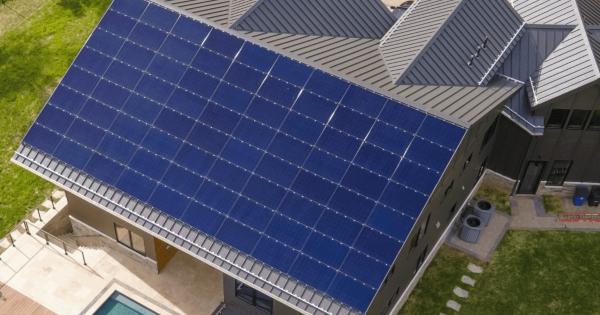Making a lasting impact on communities and the planet
April 22, 2025 at 12:00 p.m.By Dani Sheehan.
This Earth Day, we’re celebrating green roofs as powerful proof that the built environment can thrive in harmony with nature through thoughtful design.
The first Earth Day was held on April 22, 1970, in the United States. It was a massive, nationwide event, with millions of Americans participating in rallies, marches and educational activities to protest environmental degradation. Now observed in nearly every country, Earth Day serves as a reminder of the importance of environmental stewardship and collective action to address pressing environmental challenges. It is a day to celebrate the beauty and diversity of the natural world and to reaffirm our commitment to protecting it for future generations.
Our industry is strategically positioned to make an impact on humanity’s environmental impact – every surface that offers a habitat to plants and animals contributes to greater biodiversity. We often stress the energy efficiency within buildings when we talk about sustainable solutions, but sustainable solutions including rooftop gardens offer benefits that far exceed the cost savings for a homeowner. As an article in The Nation explains, green roofs effectively create a biotope that can serve as retreat sites for a variety of species. They counteract the heat island effect and act as a natural filter for dust and noise. By providing shade and facilitating evapotranspiration, green roofs can reduce the roof surface temperature by up to 56° F and lower surrounding air temperatures by as much as 20°F.
Across the country, green roofs are transforming communities, improving urban ecosystems and setting a powerful example for what our industry can accomplish when we prioritize sustainability:
Chicago’s City Hall green roof – Chicago, Illinois

Planted in 2000 as a pilot to study the environmental benefits of rooftop gardens, this 20,000-plant ecosystem sits on top of a historic municipal building. Its mix of native prairie plants was selected specifically for their toughness against sun, wind and drought, and it has become a living lab for climate resilience. The garden has paid dividends: reducing air pollution, cutting energy use, managing stormwater runoff and even helping to mitigate the urban heat island effect in the heart of downtown Chicago. It’s proof that even historic buildings can become showcases of sustainability with the right expertise.
Photo credit: Joe Wolf via Flickr
Rooftop Medicine Farm – Oakland, California

The Rooftop Medicine Farm is the largest rooftop farm on the West Coast and a groundbreaking example of how green roofs can be leveraged for social impact. Operated by the Deep Medicine Circle, this one-acre rooftop farm grows food for communities impacted by food insecurity, including patients at UCSF Benioff Children’s Hospital Oakland. The farm operates on Indigenous principles and does not sell its produce, instead giving it away through community programs and Native-led food businesses.
National Bohemian Brewery – Baltimore, Maryland

The historic National Bohemian Brewery underwent a transformative rehabilitation that perfectly blended preservation with sustainability. In 2004, the brewery’s flat rooftops were outfitted with 14,500 square feet of modular green roof trays, primarily planted with hardy sedums. These green roofs not only enhance the building's energy efficiency but also manage stormwater runoff, contributing to the reduction of the urban heat island effect in Baltimore. Additionally, former beer-brewing tanks were repurposed to collect and store rainwater, which is then reused for irrigation and flushing toilets to further conserve water.
Cities across the country are recognizing the power of green roofs – they make the built environment more resilient, reduce operating costs and offer long-term environmental returns. How can you go green on your next roofing project?
Cover image source: Green Roofs for Healthy Cities
Stay up to date with the latest industry news when you sign up for the Coffee Shop eNews.
























Comments
Leave a Reply
Have an account? Login to leave a comment!
Sign In